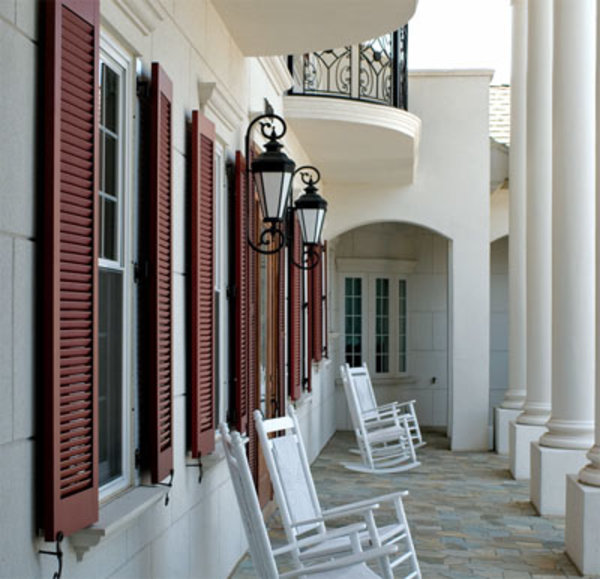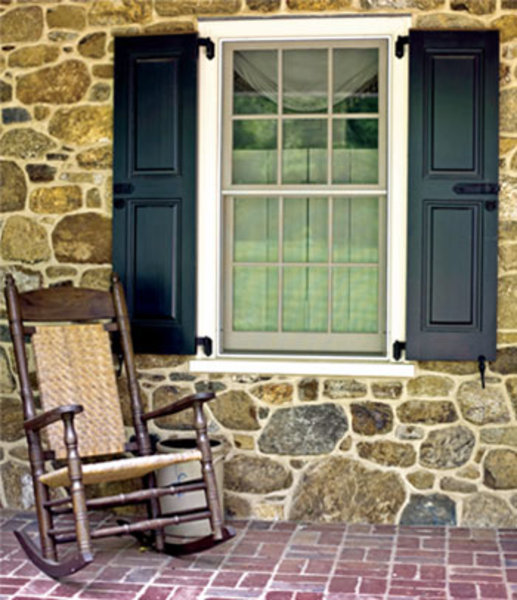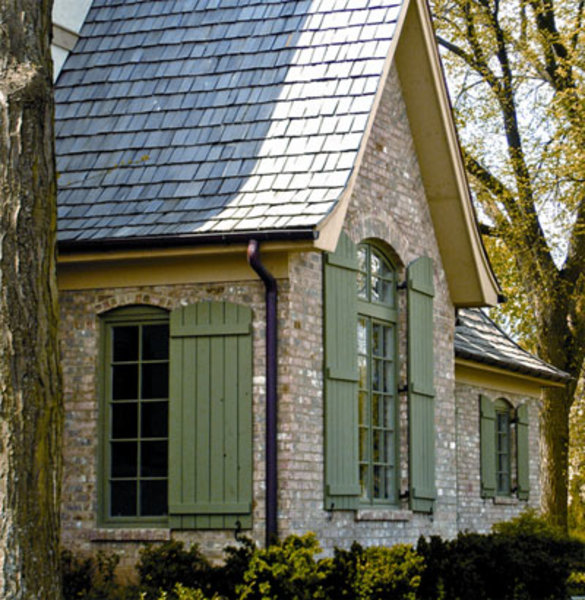
Louvered shutters are angled so that they will shed water when closed. (Photo: Atlantic Premium Shutter)
Whether your home is a true colonial, Colonial Revival, Storybook, or another Romantic Revival variation, shutters add relief and a solid dose of contrast or color to the exterior, bringing its details into focus.
While the most common type of exterior shutter is the fixed louver, other forms include movable louver, paneled, combination, board-and-batten, and Bermuda. Louvered shutters are composed of horizontal slats held in place by stiles and rails. Movable versions are equipped with a narrow post that allows for the adjustment of the slats to permit more or less light, privacy, and ventilation.

Deeply beveled panels, rabbeted channels, and properly hung, functional hardware are all hallmarks of period-specific shutters. (Photo: Vixen Hill)
Paneled shutters have solid beveled (“raised”) or flat planks. These can be embellished with decorative cut-outs in simple, classic designs like stars, hearts, acorns, or four-leaf clovers.
Since individual shutters usually feature two (or even three) panels or sections of louvers, it’s easy to create shutters that combine both styles. A typical combination might be raised panel below, louver above, or vice versa. For additional decorative impact, add a decorative cut-out to the flat face of the panel.
Board-and-batten shutters are composed of long vertical strips secured with cross members. A variation is tongue-and-groove, which have interlocking planks, similar to beadboard. Another configuration is the Bermuda, a single, full-width louvered panel that is hinged from the top and swings out at the bottom, like older wooden storm windows. Bermuda shutters are making a comeback in beach communities and tropical locales, where they can come in handy during hurricane season.

Board-and-batten shutters give a house a picturesque look. (Photo: Designer Doors)
While shutters can be specified in woods like Western red cedar and Honduras mahogany, many operable period-look shutters are made of composite materials that are moisture-, rot-, and termite-resistant. Others may incorporate weather-impervious, marine-grade fiberglass.
In order to look right and operate properly, shutters should be the same shape as the window sash for which they are intended. A pair (or single shutter, in the case of Bermuda styles) should cover the window completely when closed. Hang the shutters on the inside of the window casing, next to the sash. When you measure, take care to determine whether the opening is actually square (it probably isn’t); the depth of the reveal, which is the thickness of the channel allotted for the shutter; and the appropriate amount of clearance needed to permit opening and closing. Check with your manufacturer for more help on measuring before you order.
Last but not least: If you’ve chosen shutters with louvers, make sure the louvers face down and toward the house when they’re in the open position. That way, should you ever need to close them, the louvers will shunt rainwater away from the window, rather than against it—a real consideration if anyone in your household tends to leave windows open during a thunderstorm!







